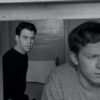Read all our coverage of the 2011 Toronto International Film Festival here.
There’s an uncomfortable if surprisingly powerful parallel “The Patron Saints” makes as it enters an unidentified nursing home in America, comparing the disconnect one usually experiences walking into a movie theater with what occurs when confronted with a place that society too often forgets. The husband-and-wife filmmaking team of Brian M. Cassidy and Melanie Shatzky shot over 60 hours of footage in the facility, yet strip away much of the film’s cinematic pretense by simply observing its residents, drifting out in and out of the rooms of the elderly as they battle the perils of their advanced age and some appreciate simple pleasures such as having their hair shampooed while others exist in a permanent stasis.
“The Patron Saints” literally finds its voice through Jim, a sardonic Billy Pilgrim-esque observer of all around him, who is physically paralyzed but still is able to let his mind roam free. His narration adds a dash of hard-won perspective to Cassidy and Shatzky’s elegiac portrait of the nursing home, where the loss of spirit isn’t represented by those that live there, but by the occasional sweepstakes for $25 Target gift cards that will likely remained unused, the entertainers that stop by to croon Lionel Richie’s “Hello” to disinterested patients, and the pastel-painted walls that are as grim as the foreboding grey skies that seem eternal outside. During their stay at the Toronto Film Festival, Cassidy and Shatzky graciously took the time to discuss how they became attracted to a subject so many shy away from, the process of putting the film together over a number of years, and whether they’ve employed the same style for their next feature, the upcoming Melissa Leo-starring drama “Francine.”
How did you become interested in this subject?
Brian Cassidy: We were location scouting for another film we were making and our protagonist was going to be working in a nursing home. That scene didn’t make it into the film, but by that point, we had built relationships and gained access to this incredible facility and felt that while it wasn’t going to work for our short film, we wanted to stay and make a portrait of this place.
Melanie Shatsky: And we didn’t start making the film right away. We were there five years ago and then two years after that point, we thought wow, that place is really interesting. We should really go back. It seems like a really rich community in a way that we’ve never seen featured in film.
This may be a poor choice of words, but given Brian’s work on the flea market doc “Fish Kill Flea” and your previous film together “God Provides” related to Hurricane Katrina, are subjects that could be considered neglected something you’re specifically interested in?
MS: I wouldn’t say the residents of the nursing home are neglected, not at all. They are well cared for, but I think it’s a very enclosed community that is hidden from view and I think that’s what we were interested in. “Fish Kill” was also an enclosed community in a way.
BC: We’re wary of using words like neglect because while from our perspective there’s in some ways perhaps a spiritual kind of neglect or familial neglect, we don’t want to judge that. We go and we witness what we do and then we choose to portray things from our own viewpoint. Words like neglect tend to carry an absolute value to them. It’s fine for other people to come away with that if that’s what they want to come away with…we don’t judge in any kind of way what’s going on. The tendency is to see people of a certain age, whether they’re [in] retirement communities or nursing homes, focusing on the exception not the rule, meaning a film about the geriatric synchronized swimming team or a few that come together and form a band. These are fine interpretations and they’re uplifting and they’re empowering, but from our standpoint, that’s the exception of the rule and we wanted to make a film in which you kind of pull the curtain back on those [the public] tends to want to look away from.
MS: Just picking up where Brian left off, the tendency to want to portray people that still have their faculties at a certain age [is] very empowering, but they leave out so many of these other people who that’s not their fate to still have their minds intact and yet there’s still a great humanity in these people if they still have Alzheimer’s and dementia. There’s still some important stories to be told, so that’s what we wanted to look at.
Is that also why you rarely see the staff or the patients’ families around?
BC: We wanted to focus on the experience of the residents themselves in a more…
MS: …A more concentrated way. There seems to be a lot of work [in film already] that talks about nursing home care. For us, it really wasn’t about the care or the facility that they’re in. This could’ve been any facility. It was really a focus on what happens to the mind and body at the end of life.
How did you guys meet Jim and how did he become the center of the film?
MS: He really stood out to us. When we were first there five years ago, we saw him and thought my god, he doesn’t look like he belongs. Even though he’s in a wheelchair, I was intimidated by him because he looked like somewhere between like a mafia guy and a biker dude, so he seemed out of place. Then a couple years later, we went back and started talking to him and found out that he was the kindest person. It was funny that I should feel afraid of him. We just thought he had a very unique point of view being there because his mind is still intact, but he’s in this community with people that are a generation or two older than him and a lot of them have Alzheimer’s and dementia, so it’s a very strange place for him to be. I think his reality is a lot more strange than the rest of the residents there.
BC: He has a degree of awareness of his circumstances at all times that makes him hypersensitive to everything else around him. It led us to find stories of the other residents through him and for him then to sort of hold our hand through this facility and through this experience.
Through the five years that you were visiting, I imagine patients came and went. How did you figure out how to turn this into a film?
BC: The way we worked on it was we shot the film over the span of five years, but that doesn’t mean we were there shooting for five years. Over that course, we probably shot for a few months. We set up some rules that we wanted to follow, a structural aesthetic of how the camera would move, the pacing and so on. Giving ourselves those kinds of limitations helped us to find where we needed to go, but also made it a challenge to get there.
What we would do is we would film and then we would come home and did some editing and that bit of editing would tell us a little bit more about where we were headed, so it was almost like the process of writing as we go. Editing and shooting were like a parallel process rather than [how it is] in more cinema verite documentaries…
MS: …Where you come home with 200 hours and then you’re like what do I do with all this?!? I think once we found Jim though, and he was able to narrate the piece, that really brought everything together. That helped dictate what became relevant and what wasn’t because he acted as this binding force.
It was announced during Toronto that you’ve already wrapped your next feature “Francine,” your first narrative feature and while I don’t want to pry too much, did you find yourself approaching it in a similar way to “Patron Saints”? There’s a lyrical quality to the documentary that would seem to translate.
MS: I think it does translate, maybe not to the same extent as [“Patron Saints”] does because obviously you have to plan some things in advance with narrative whereas I think that lyrical stuff comes from when things are unplanned, perhaps. But Brian and I both come from background as photographers, so we’re very used to looking at singular images that tell a whole story and we try to bring that to our filmmaking.
BC: But we found in some cases, that doesn’t work. Over the course of the last few pieces we’ve made, what we’ve noticed is that what of our photographic concerns are relevant to cinema and what aren’t. When you add the element of time in cinema and a continuous movement, certain senses of composition or internal resolution of an idea within a frame can be great in cinema as punctuation, almost like the beginning or the end of something, but if one takes too much of a photographic interest…
MS: Then it’s too resolved.
BC: Yeah, it’s heavy handed or it’s contrived.
MS: That’s the flip side, but to answer your question more specifically, saying that this forthcoming film is narrative, we wanted to preserve some of those kind of documentary methods. Even though the film is feature-length, the script is only 10 pages long, so we don’t write out dialogue. We only write out scene descriptions, what’s the intention of the scene, what happens here, how it leads you to the next scene, so that there’s still a lot of space within a given scene for surprises, for improvisation. For us, that poses some challenges too, but we feel it preserves a little bit of that lyrical thing.
BC: And it’s also what is outside of the margins for us. In “Francine,” there is that experiential thing where you’re with a woman through her experiences, but there’s a lot that’s left untold. For us, that’s where things begin to happen.
"The Patron Saints" does not yet have U.S. distribution. It plays Toronto once more on September 18th at the AMC 9.




There’s a lot of issues presented in the film. It’s not just about how the nursing home goes on its day by day routine but what the elderly experiences.